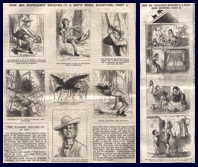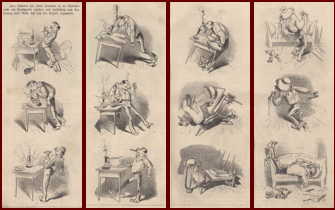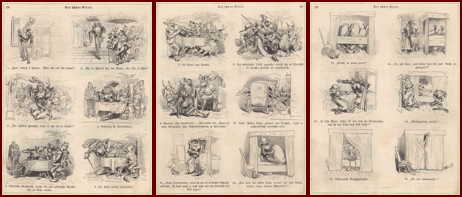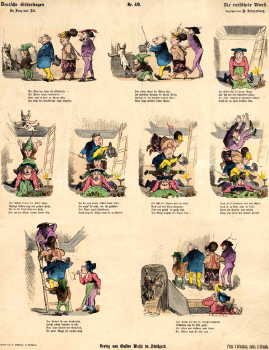
Home A-Z A-Z text British German Unidentified Reprint Birth Sunday Chronological
Chronological Version
1700 - 1800
|
William Hogarth 'The Harlot's Progress (1730)
small version click here
|
|
The famous 'progressions' by Hogarth were not actually comics. The images don't lead into and don't interact with each other. Each shows a distinct, separate stage of a longer story. However, because of their great popularity, they established the very notion of telling entertaining stories with a series of pictures and so became a highly influencial stepping stone for future developments. |

|
|
Franz Joseph Goez 'Lenardo und Blandine' 1783 |
|
Ironically this, the first actual graphic novel(ette), probably had little influence. It was too ahead of its time as far as the comic-structure is concerned. In content it was delightfully very much of its time, full of outrageous melodrama.
Here's the complete sequence, with my translation underneath: |
page 1-34
page 35-65
page 66-93
page 94-125
page 126-160
All on one page
 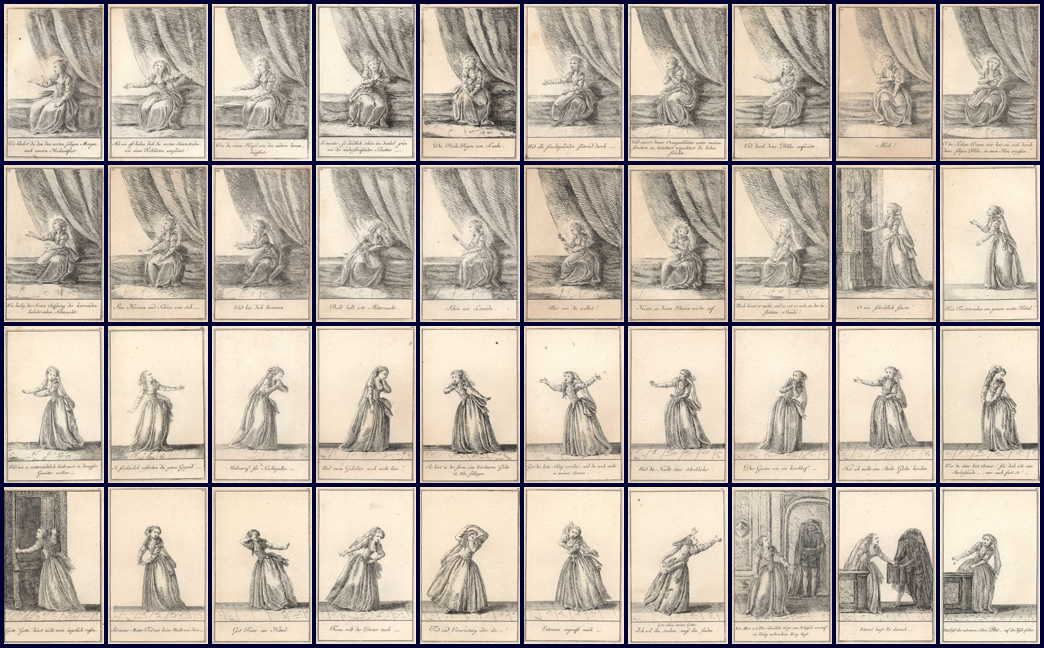 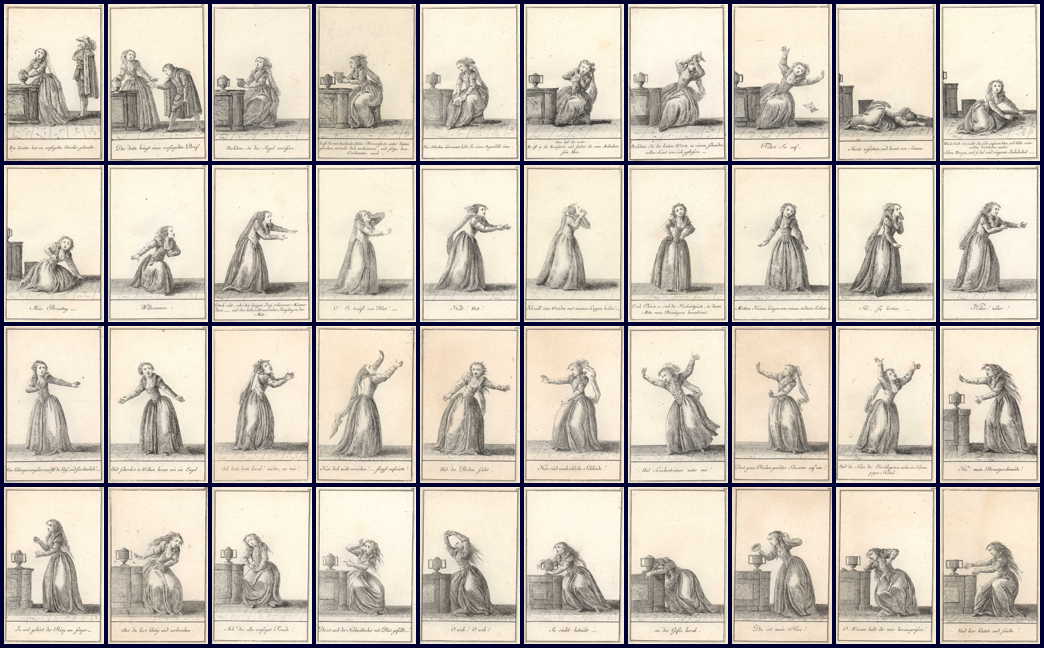  |
| James Gillray - 'The Table's turned - Billy in the devil's claws / Billy sending the devil packing' |
|
Much more influencial than Hogarth or Goez were the thousands of British political cartoons. Most were just that, cartoons, meaning single image jokes. However, a huge number of them used (and developed the use of) speechbaloons. And a good number did in fact use two or more interdependant images to tell a story. (That means they were comics.)
|
 |
Chinese Woodcut 'How China is Made' (china = porcelain) (late 18th cent., reprinted 1893)  |
1800 - 1840 (pre-Töpffer)
|
William Heath - 'White Bait' (1830)
(a four-panel comic strip with speechbaloons) 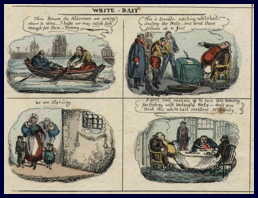 |
|
Thomas Rowlandson Part 1 - 'THE TOUR of DOCTOR SYNTAX, In search of the PICTURESQUE' |
|
This is not a comic. It's not even a sequential series of images, like a Hogarthian progress, or even illustrations of a novel.
But it can be seen as a milestone in comics history, because of the influence on Rodolphe Toepffer, who imitated the type of main character, the drawing style and the general atmosphere of countryfied wackyness.
The use and re-use of one striking visual character, generally recognized and popular, is certainly typical of many comics to come.
|
The Birth of Modern Comics (1800-1860)
|
Modern comics, with a storytelling vocabulary that's still used today, were developed in America's newspaper strips, circa 1900-1920. They were mostly following a tradition of short, colourful picture-stories for children. The direct influence was the slapstick work by Wilhelm Busch and others in a similar vein. But that in turn was built on a sixty year (or more) tradition of children's comics.
Busch started working in 1859, for a series of picture broadsheets called 'Münchner Bilderbogen' (See below, or click here for examples), which had been going since 1849, a series which included many inventive and sumptiously illustrated comics from the start. These were themselves influenced by the charmingly naive 'Neuruppiner Bilderbogen', which started producing comic-like picture stories in 1835. And those again were influenced by British chapbooks with comic-like picture stories, starting around 1800. Even earlier were precursors in Holland. Below are a number of examples, in case you think I'm making this all up. First two very early examples from Holland. It seems that although the Dutch had the most spectacular fall in artistic relevance around 1700, there still was an important tradition of printmaking, and highly important for the development of comics. |
|
Urbanus and Isabel Dutch Broadsheet (circa 1750) They marry. He goes off whoring. She divorces him. Years later he comes crawling back and she is overjoyed to take him back and all is well. Maybe this one wasn't a childrens story yet (although you never know with the Dutch), but the next one is.  Little Red Ridinghood Dutch Broadsheet (1800) by G. Oortmann, publisher: by de Erve H. Rynders - earliest Dutch broadsheet after Perrault. This predates the famous Grimm's version by 11 years.  |
|
From around 1800 the most important country for comics is England. Here stories told in pictures turn up inside chap-books.
Chapbooks were small booklets of four, (or multiples of four: 8, 12,...) pages, and sold by itinerant merchants or chapmen (Old English: ceapman from 'ceap' - bargaining, trade) from the 16th to the early 19th century. They were illustrated with woodcuts and had stories of popular heroes, folklore, famous crimes, ballads, nursery rhymes, schooltexts (ABCs), bible tales, etc, and were the main literature beside the bible for the common man and children.
They too were sometimes sold as sheets which had to be cut up and bound, DIY-fashion.
Most chapbooks were not comics of course, but enough of them were to constitute a genuine and influential tradition. Some of the examples below are from American edtions. I'm not sure if these were reprints, copies or original. |
|
The Little Man & the Little Maid (1807)  The Comical Adventures of the Little Woman, Her Dog and the Pedlar (1820s) printed in Baltimore, by William Raint  Robert Branston Old Mother Hubbard and her Dog - Various early editions including a lovely one from 1819, probably by Robert Branston    Robert Branston 'The Comical Cat' (1818) Another 'Madam with an animal' thingy by Branston, plus a couple of later US variations.    Robert Branston Dame Wiggins of Lee and her Seven Wonderful Cats (1823) More an illustrated story than a comic, because not enough of the relevant action is shown visually. This was a favourite childrens book of the art critic John Ruskin.  Grandmamma Easy's Old Dame Hicket and Her Wonderful Cricket (circa 1840) Boston: Brown, Bazin & Co. Nashua, N.H.: N.P Greene & Co.  There are a lot more of these wacky old-Mother-this-Grandma-that picture books. Below examples of more conventional 19th century stories. The Two Sisters (circa 1825) From The Pretty Primer (The Juvenile Gem), Huestis & Cozans, 104 Nassau Street, New York  The Story of Little Sarah and Her Johnny-Cake (circa 1830) Boston: W.J.Reynolds & Co.  The Children in the Wood (circa 1825) published by Dunigan, New York  Adventures of Little Red Riding Hood (circa 1820) Mark's Edition - Published by Fisk & Little, 82 State-Street, Albany, New York  |
|
These chapbooks had an important influence on the next stage of mass-market comics for children.
In the mid 1830s the little town of Neuruppin, north of Berlin, became an important centre for picture sheets. A good number of these were comics. Below are a few early examples.
Later on, in 1848, these Neuruppiner Bilderbogen themselves influenced the more sophisticated 'Münchner Bilderbogen' (Munich picture broadsheets), where in 1859 the great Wilhelm Busch started his own brand of picture stories, which would influence cartoonists all over the world, and eventually the Sunday supplement comics. In other words, there is a direct line of influence from the Dutch broadsheets/ English chapbooks to 20th century comics. |
|
Geschichte der Madam Rips und ihres Hundes Bello 1835/40 This sheet demonstrates the international influence of British picture stories - a close copy of Old Hubbard, translated into German: (the English version was here) . Bello comes from 'bellen', to bark. Typical doggie name. 
More common were these charming fairy tale adaptations: Cinderella 1835/40  Hansel and Gretel (here called Martin and Ilse) 1835/40 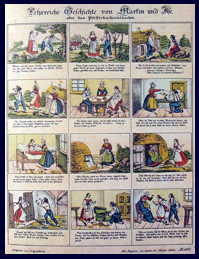 Erzählung vom kleinen Däumling / Story about Little Tom Thumb (1835/40)  Schneeweisschen und Rosenrot (1835/40) (Little Snowwhite and Rosered) (not the Snowwhite, who is called 'Schneewittchen' in German)  There were also popular stories of romantic robbers: Rinaldo Rinaldini (1835/40) ...  ...or a satire for grown-ups about emancipated women (and why to avoid them): Der Kleine Mann und die grosse Frau (The little Man and the large Woman) (1835/40)  Heinrich Hoffmann 'Struwwelpeter' (drawn 1844, published 1847 - English edition 1848) |
| This famous picture book is stylistically related to earlier chapbooks and Bilderbogen / picture broad sheets. The hunter/rabbit story is similar to a panel from an earlier Bilderbogen showing (non-sequential) instances of a 'topsy turvy' world. |
 |
Rodolphe Töpffer
1840 - 1860 (pre-Busch)
1860-1900 (The Magazine Comics Period)
1895-1900 (The Sunday Supplements)

A-Z (these lead to the links above)
If you have questions about early comics, please direct them to this mailing list: Platinum Age Comics
Copyright © 2011 by Andy Konky Kru
Home
|
Index Monsieur Vieuxbois (1839) (partial translation) the same, but with smaller pictures - click here  Comparison of the Aubert Pirate Version (1839) and the US copy (1842)   Comparison of Monsieur Tric Trac and a Dutch sequel (Prikkebeen)  Comparison of Vieuxbois and Cruikshank  EXTERNAL LINK: 'Histoire de Mr. Vieux Bois' Original manuscript version of Monsieur Vieuxbois, 1827 (30 pages/158 panels) with text typed out underneath, and a translation. The first printed edition was published ten years later, expanded to 88 pages/198 panels. The second edition 1839 (as presented above on my own site) had 92 pages / 220 panels. |
1840 - 1860 (pre-Busch)
|
Alfred Crowquill (Alfred Henry Forrester) 'Pantomime, to be played at home' 1849  |
|
Gustave Doré 'Trois artistes incompris et mecontens' (1858) - Outstanding lithos by his own hand part 1 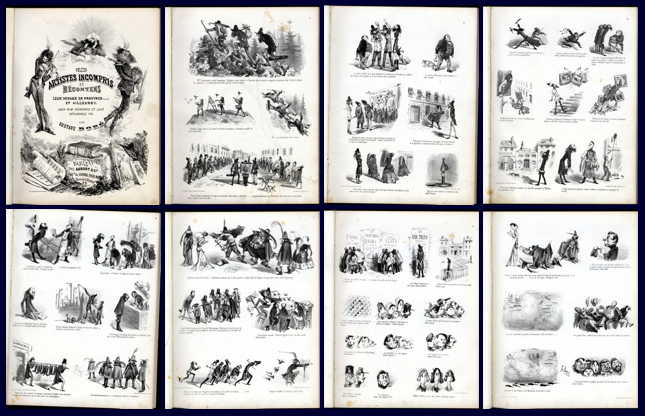 part 2  part 3 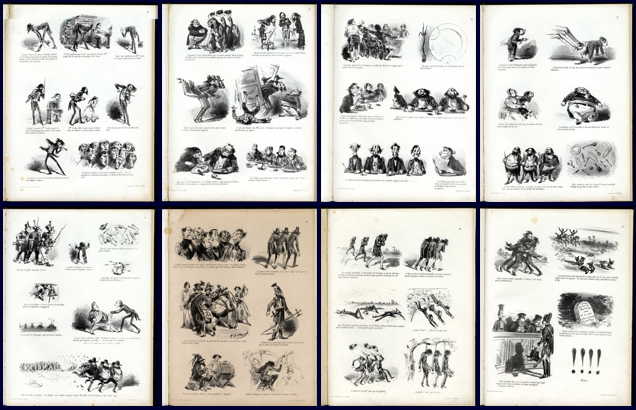 |
Richard Doyle- Pleasure Trips of Brown, Jones and Robertson - from Punch, 1850  |
Grandville - A dream of crime and punishment, Gertrude (1847) |
Anonymous - Two comics from the magazine 'Die Illustrierte Welt' Stuttgart (1858) (sechster Jahrgang)
 |
Pages from the magazine 'Leuchtkugeln' 1848 |
Timol?on Marie Lobrichon Histoire de Mr. Tuberculus (1856) (only a few pages) |
|
JohnTenniel (the illustrator of Alice in Wonderland, 1864) How Mr. Peter Piper Enjoyed a Day's 'Pig-sticking' 1853  How Mr. Peter Piper Tried his Hand at Buffalo-shooting 1853  How Mr. Peter Piper Was Induced to Join in a Bear-hunt 1853  How Mr. Peter Piper Accepted an Invitation from the Rajah of R. to Hunt a 'Royal Bengal Tiger' 1853  Mr. Piper (all on one page)
|
1860-1900 (The Magazine Comics Period)
| Album Noel (all) 1900 (collecting work from previous years) (This link presents all the pages from the book in one go. Most of them are also listed separately by author). |
G. Andral 'La clémence d'Auguste' (Le journal pour tous' 1895) |
F. von B. 'Der schlaue Pepi - oder - Die geraubte Gans' (Fliegende Blätter vol 82) |
|
Johann Bahr 'Der kurzsichtige Bassgeiger' (The short-sighted bass-player) (without words)  'Schnelles Wachstum' (Fast Growth) (without words)  'The Mechanical Racehorse' (originally in 'Lustige Blätter' 1892, here also from 'Picture Magazine' 1893) 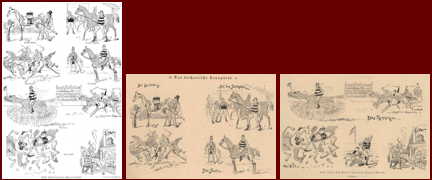 Die Rivalen auf dem Eise (Lustige Blätter 1892)  Die verrätherische Fata Morgana (Lustige Blätter 1892) (without words) (Speech by Professor Strubelmann on how to take care of your hair) (Lustige Blätter 1892)  Der kluge Plüsecke (Lustige Blätter 1892)  'Der Sonntagsfrevler - oder - Die verbotene Angelei' (Lustige Blätter 1892)  'Der gefoppte Schwarzseher' (Lustige Blätter 1892) (without words)  |
|
Baric - 'Histoire de Martin Landor' ou 'La musique des enfants' ecrite par Kroknotski, dessinée par Baric' 1865 This is only partially a picture story (ie comic). But it shows a different way how the Struwwelpeter influened picture books. Also, it's a precursor of McCay dream-stories, with equal visual brilliance.  |
Frank Beard 'It Didn't Work for a Cent' (from Puck 'On the Road' 1889)  |
Edouart Bernard 'Une ligne résistante' (Polichinelle 1898 - Journal humoristique hébdomadaire pour la famille)  |
C.J.Budd 'The Bill-Poster's Revenge' (Harper's Round Table, Annual 1897) |
R.F. Bunner - (The Circus Lion) (Harper's Round Table, Annual 1897) (without words) |
Léonce Burret




 |
|
Randolph Caldecott The Rivals  The Wynchdale Steeplechase (scroll sideways) Our Haymaking  Carlyon's Christmas  |
|
Caran D'Ache La Loi de la Femme  Trappeur d'Arkansas ou Une Erreur Judiciaire (1893)  A popular Favourite (originally from 'La Caricature', before 1893) (a variation on 'The Virtuoso' by Busch)  (Catching the train) (before 1893)  La Vie de Chateau 1897  A la Houzarde (Le Rire, 2.November 1895)  Querelle d'Allemand (Le Rire - 25 January 1896)  Le Ténor enteté  |
George Chicki - Souvenirs Bachotiques (1870) (graphic novel in the manner of Töpffer)  |
Chip (F.P.W. Bellew)
The Rivals' A Tale of St. Valentine ('Chip's Dogs', 1895 )
 |
|
Christophe (Georges Colomb) La Fontaine Modernis? - Le Renard et la Cigogne (Petit France 1901, Number 108  Le Malices de Plick et Plock (Petit France 1902, Number 122) This page shows how much Christophe was influenced by German cartoonists. Wilhelm Busch's Icepeter motiv is turning up again, and more directly the various dwarf stories by Lothar Meggendorfer or Johan Bahr.  Le Baron de Cramoisy (Vll) - Le Petit Francais Illustré 1901  |
Emile Cohl 'Logement a Louer' (Polichinelle 9.Mai 1897)
(That's the same Cohl famous for creating the first animated cartoon.) |
J.B. Clark 'Le Maleurs d'un chat' (from 'Album Noel', 1900)  |
C.Cyl 'Peche ? la ligne' (from 'Album Noel', 1900)  |
A.S.Daggy 'A new use for the Japanese Umbrella' (Harper's Round Table, Annual 1897) (without words) |
|
Dalrymple 'The unexpected always happens' (from 'Puck's Library')  (At the theatre) (Le Rire, 11.Mai 1895 - originally published in Puck)  'His Diploma'  |
|
Deb Un essai (from 'Album Noel', 1900) 
Souvenir de pêche (from 'Album Noel', 1900)  |
|
Jules Dépaquit Le Bourreau trop vigoureux - ou - erreur n'est pas compte Zola veut séduire l'académie Carneval (1897 - Le Rire) 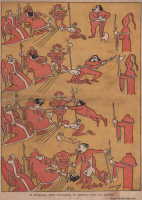
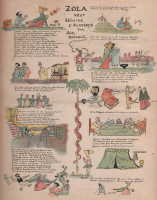
 |
Dio Biding 'La méchanceté' (from 'Polichinelle' 9.Mai 1897) |
|
Doës Polly's Little Joke (from 'Le Papillon', reprinted in Picture Magazine 1893) 
Subjection (from 'Scribner's Magazine') 
How Pierre sent his Boots by Telegraph and got a Receipt for them (from 'La Revue illustré, reprinted in Picture Magazine 1893) 
|
A. Douhin 'Génération Spontanée' (from 'Journal Amusant' 11. November 1899)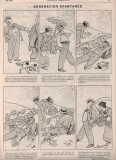 |
M. Dunk 'How a Famous Hunter Won a Reputation' (Harper's Round Table, Annual 1897) (without words) |
|
Fernand Fau (Champagne) (Le Rire, 11.Mai 1895)  La Création du monde  Le Duel Pini-Thomeguex (Le Rire, 11.Mai 1895) Cartoon with a speechballoon, influenced by Caran d'Ache.  Échos de la semaine prochaine (Le Rire, 14 April 1896)  Interviews printaniers (Le Rire, 4.Mai 1895)  Etre président de la république (Le Rire, 14 April 1896)  |
A. B. Frost 'He was a Tenderfoot' (from Scribner's Magazine Vol.XIII No.1, January 1893 )  |
Gerlach 'A Tale of a Lamp and a Bath' (from'Universum', reprinted in Picture Magazine 1893) |
Godefroy 'A Comfortable Smoke' (from Revue Illustr? - reprinted Picture Magazine 1893) |
W.M. Goodes 'The Funniest Thing He ever Saw' (Bear & Fishing Rod) (from Harper's Round Table, Annual 1897) (without words) |
F. Graetz 'Die Wirkung der afrikanischen Sonne auf das Kilimandscharo-Gebiet' (1892) (Lustige Blätter)  |
|
Syd B. Griffin 'Snap-Shots'/A Friend in Need 
His Name was Mud (from Puck's Library) 
Let Her Go  |
|
O. Herford 'The Bow Legged Admiral and the Educated Dog' (Harper's Round Table, 1897) 
'The Lost Joke Recovered by Xray'(Harper's Round Table, 1897) |
Livingstone Hopkins 'Professor Tigwissel' (1875) - very early U.S. newspaper comic
|
|
F.M. Howarth Récréation Chinoise (from 'Album Noel', 1900)  Editor and Poet (Puck 1894)  'An ingenious Device' (originally published in Life - reprinted in Picture Magazine 1893)  'Lovers of Art' (originally published in Life - reprinted in Picture Magazine 1893)  'Pelle et Brouette' (originally published in Puck, reprinted in 'Polichinelle' 31 July 1898)  Le Portrait trop resemblant et la veuve trop démonstrative' (originally published in Puck - reprinted in Le Rire, 4.Mai 1895)  Un enlevement acrobatique ou le vrai amour ne connait pas d'obstacles' (originally published in Puck - reprinted in Le Rire - 9 May 1896 )  The dog at the butcher's (orginially published in 'Judge' - reprinted in Le Rire, 2.November 1895)  An Assisted Flirtation (Puck 28. July 1897 )  Easily Arranged (Puck 28. July 1897 )  External link (John Adcock's Blog) Selfportrait & short strip |
|
A. Jensen 'Der Abgeordnete und der Wähler' (Lustige Blätter 1892) (the often repeated visual joke of relating the size of people to their power or importance)  'Die 'Vermehlung' des Schornsteinfegers' (Lustige Blätter 1892)  'Die Ratte' (Lustige Blätter 1892)  'Ein armer Lahmer' (Lustige Blätter 1892) 
|
Charles Keene (1823-91) 'The Adventures of Miss Lavinia Brounjones' (Punch 1866)
|
W.C.Kemble 'An Ingenious Escape' (Harper's Round Table, Annual 1897)
|
|
Kerlie? 'Histoire de deux chinois et d'un enfant trop malin pour son age'  'Histoire lamentable de Prosper et de sa soupe' 
|
C. Koch (Deutsche Bilderbogen 162 - Gustav Weise Stuttgart) 
|
Ch. Lagemann 'Der zerstreute Professor oder Eine Überraschung' (Lustige Blätter 1892)  |
Le Bocain (jeune ou vieille?) (Le Rire, 11.Mai 1895) 
|
|
Achille Lemot (aka Uzès)
(all from 'Album Noel', 1900) Avec de la tenacité Un jeune inventeur 'A.L.' 'Fourrures a l'essai! C'est que la vie (A.L. in the squiggly border) Une Faute de Gugusse (the classic hosepipe gag) Une tartine pour trois Maladroit mais rusé Un farceur attrapé ou un voleur envolé Punition mériteée Valeur du temps Une lecon de botanique Ce qu'il en coute d'apprendre à un éléphant à se balancer Un tour de force Rira bien qui rira le dernier Les cinq sens (not a comic) 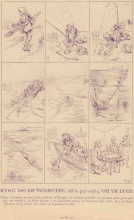

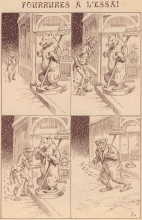












|
|
Luc Luguey Le Rire - 14 March 1896  La nuit de noces du Viveur (containing small speechballoon) 
|
Alfred Le Petit - 'En Chasse' ('Polichinelle' 9.Mai 1897)  |
Leoy (Variation on 'The Virtuoso' by Busch) (reprinted in Picture Magazine 1893)  |
|
H.Malatesta 'Le voleur bien volé' 1895 (from 'Album Noel', 1900) 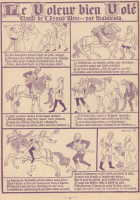
'Le bon pauvre et le mauvais riche' (from 'Album Noel', 1900) 
'Le Fils d'Adoption' 1896 (from 'Album Noel', 1900) 
|
M. Mandl 'Praktische Verwertung der neuesten Mode' ('Practical application of the latest fashion') (1885) (Fliegende Bl&amul;tter vol 82) |
George du Maurier 'The Philosopher's Revenge' (Punch 1866) |
|
Chas May Un sac, un homme, un chien & un tonneau (from 'Album Noel', 1900) 
Dans la cave (from 'Album Noel', 1900) 
|
Hy Mayer 'How the Dromedary became a Camel' (Harper's Round Table, Annual 1897)
 |
John Mclenan 'The Flight of Abraham - as reported by a Modern Daily Paper' (Harper's Weekly 1861)  |
|
Lothar Meggendorfer Aus den Kinderjahren eines Kautschukmenschen (from the infant years of the plastic man)  Rache ist süss (Revenge is sweet)  Die schlauen Zwerge (The Clever Dwarfes)  Misslungene Arretierung (Unsuccessful Arrest)  Liebesgram und Heilung (Love sickness and Recuperation)  Das bockbeinige Schwein und der Philosoph (The recalcitrant pig and the philosopher)  Die Macht der Musik' (FB 1888) 
|
|
Mob L'aumone Un drame Pêche difficile Repos Troublé 

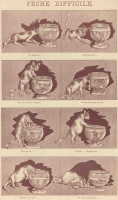

|
|
M. Monnier 'La Punition d'un Gourmand' (The punishment of a glutton) ('Le Petit Francais' 26.April 1902)
A forerunner of McCay's dream comics !!!  |
|
Moriss - Interruption Piquante (Note - The chap is reading the magazine in which the comic is published)  |
|
Peter Newell (Policeman and Matchstick) (Harper's Round Table, Annual 1897)  'Introduction' (Harper's Round Table, Annual 1896) 
|
|
Adolf Oberländer Illustrierte Anzeige - Ein Grotesktänzer, durch Kabalne dem Ballett entrissen, empfielt sich als Bodenwichser  Ein jedes Tierchen hat sein Pläsierchen - 1885  Zufalls Tücke - oder - Unfreiwillige Illustration - 1885  Die kurzsichtige Tante (The shortsighted aunt) 1903  Münchener Tartarus (1865)  Die unterbrochene Trauung (1865)  Täuschung - (text with three illustrations) (1865)  Der Wunderdoktor (1865) 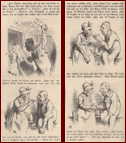 |
|
Fred Opper (before 1900)
(see also the post-1900 Opper Index) The Wicket Seal Hunter and the Clever Seal  His Doctors, and how they didn't do him any good  A Real English Outfit in America 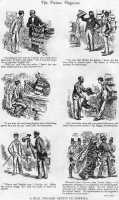 In Maine  The Result of Feeding a Neapolitan Greyhound on Macaroni  The Power of Habit  A Close Shave  (The Pretty Typewriter)  Mike Cassedy's Toothache  A Distinct Success  Saved - A Tale of Simple Heroism Rewarded  The latest dodge  A story of the road 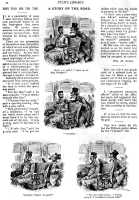 A Quick Response  A slight error of judgement  Not quite out of practice  True too his word (Puck 28. July 1897) 
|
|
Photo Comics Le premier cigare  Histoire d'un nid (not photos, only traced from photos) 
Saluting the Flag - 1912 
Hunter and Dog 1899 
|
Emile Piery - Fantaisie sur le duel (from 'Polichinelle' 31 July 1898)
|
H.W. Philips - A Friend in Need is a Friend Indeed (Harper's Round Table, Annual 1897) |
|
Karl Pommerhanz Ein Frechdachs  Der getäuschte Arzt  Die Benutzte Gelegenheit  Die kleinen Verwandlungskünstler  Der Herr Professor und das Feuerwerk  Das boshafte Geschwisterpaar  Die Pferdelspieler  Der kleine Turner und seine Lebensrettung  Bestrafte Unhöflichkeit (1892) 
|
J. S. Pughe A Small Story with a Large Application (from Puck 28.July 1897) |
|
Benjamin Rabier Le Lion Télescopé (Le Rire - 11 April 1896 )  Gontran à Trouville (Le Rire - 27 June 1896 )  |
Carl Reinhardt (Die Landpartie) (Deutsche Bilderbogen f˘r Jung und Alt Nr.96) |
Reichert 'Un Drame en deux actes avec trois personnages' (from 'Album Noel', 1900)  |
|
Emil Reinicke Das jähzornige Nashorn' (The angry Rhino) (1886)  Die verschwundene Wurst - Eine merkwürdige Begebenheit (FB 1885)  Irren ist Menschlich (to err is human) (FB 1884)  Iberus - Eine antimusikalische Ballade (FB 1884)  Dr. Mokel in Afrika (FB 1884)  Sächsisches Landsknechtlied (FB 1885)  Das Kegelspiel - Historisches Gedicht (FB 1885)  Der Kluge Elefant (The clever elephant) (1902)  Der durstige Jumbo' (Thirsty Jumbo) (1902) 
|
K.Rey 'Une histoire qui finit mal'(from 'Album Noel', 1900)  |
F. Reznicek

 |
|
F.T. Richards It's an Ill Wind Blows Nobody Good (Harper's Round Table, 1897)  The Fakir and the Prestidigitateur (Harper's Round Table, 1897)  An Occidental Transformation (Harper's Round Table, 1897) 
|
|
Charles Ross & Marie Duval
'Ally Sloper' (magazine pages rearranged for an early reprint in bookform, 1867)    |
A.Rusden 'La Peau du Lion' (from 'Album Noel', 1900) 
|
|
H. Scherenberg Der Bauer und der Kobold (The peasant and the kobold) Die entführte Wurst (The kidnapped sausage) Das Ständchen (The serenade) Ferientag eines Zerstreuten (Holiday of someone very distracted) Die Drei Wünsche (The three wishes) |
Schmelzer 'Hansl und Gretel - oder - Nach und nach' (1865) (Fliegende Blätter vol.46) |
R. Schönborn (Drei Räuber) (Deutsche Bilderbogen Nr.105)  |
Schliessmann 'Der Sechsf˘ssler - ein Clownscherz' (The six-footer, a clownish joke) |
|
James A. (Affleck) Shepherd (1867-1946) Index Parrot and Dog (Boys' Own Paper 1891) (uses plot-relevant speechballoons)  Les Grenouilles et le héron (from 'Album Noel', 1900)  |
|
C. Storch Der Automobilfahrer wider Willen (The unwilling motorist)  Bestrafter Geiz (Punished Selfishness)  Blinder Eifer (Blind Zeal)  Glück im Unglück - Storch after Pomerhanz  Gnom und Maulwurf (Gnome and Mole)  Der Maler und der Stier (The Painter and the Bull)  Verunglückter Musikuntericht (The music lesson that went wrong)  Die Zwerge und der Fischer (The Dwarfs and the Fisherman) 
|
H. Storkmann (French reprint) (originally published in Fliegende Blätter) |
James Francis Sullivan |
John Theele 'Die f˘nf Sinne' (The five senses) (Lustige Bl&aumml;tter 1892) |
|
M. Tucker 760 - - 'The Stolen Cigar or The Monkey who got it in the Neck' Tucker ?  |
M. Vaiselow 'Das gewohnte Stichwort' (Lustige Bl&aumml;tter 1892)  |
|
Gustav Verbeek 'The Hunter's Strategy' (Harper's Round Table, Annual 1897)  'A quelque chose malheur est bon' (The Swan)  |
S. Vitou 'Der Photograph in der W˘ste - Vorzug der Revolver Camera' (Lustige Bl&aumml;tter 1892)  |
|
Zim (Eugene Zimmerman) Index Blackville (originally published in 'Judge')  (Mule Récalcitrant) (originally published in 'Judge')  ('Le Renseignement exact') (originally published in 'Judge') 
|
1895-1900 (The Sunday Supplements)

|
Eventually there should be a section presenting this crucial period in more detail. At the moment I don't have sufficient material. Magazine comics from that time will remain in the preceding section.
It is difficult to decide how important the development of comics in humorous magazines and in the newspapers respectively were, without studying a lot more of the work. Below you can at least sample the visual flavour of one magazine and that exciting new thing, a comics supplement, both from the summer of 1897. At the time it wasn't clear that it would be the supplements which would develop into modern comics. Magazines like Puck, which were based on German magazines of the time, such as 'Lustige Blätter', were stuck in a bit of a rut. The type of comics they presented had not changed much for 30 years. But there were other magazines, such as the German weekly 'Simplizissimus' (starting April 1896), which came up with sublimely inventive designs, and satirical adult themes. HOWEVER: Looking at this Puck and the Sunday Comics Supplement , it struck me that both the format and the audience for the latter may be the cause of significant changes. The newspaper format was much larger and cheaper, providing a lot more empty space to fill. The audience was less sophisticated, but (possibly because of this) more open to a particular type of experimentation, despite the dumb and lowbrow humour. Admittedly, this is being wise in retrospect. For whatever reason, these American Sunday pages became the breeding ground for something new. Weirder, rougher, slapdashier. Also easier, for children, but not childish. More popular. More ... somethingier. Maybe it was that new type of human being, the urban immigrant, who was most prepared and eager to pay for all this new visual goings on. As you can see in the example below, early supplements didn't actually have many comics, apart from the usual short black and white snippets, similar to those in magazines. The new, enormous areas of colour were at first used for large, sometimes complex cartoons. But sequential cartoons did start to pop up with a vengeance in the form of Hans and Fritz, the Katzenjammer Kids, based on the popular classic 'Max und Moritz' (1864) by Wilhelm Busch. These two remarkable rapscallions appeared onto this stage of coloured spreads a few months later, on the 12th of December 1897. The Busch influence was of course felt througout the 'magazine-comics-period' 1860-1900. But in young Dirks he had finally found a follower of genius, who together with other likeminded artists, and above all an avaricious public, created the new parameters of the medium. |
|
Puck 28. July 1897 Small version - Large version 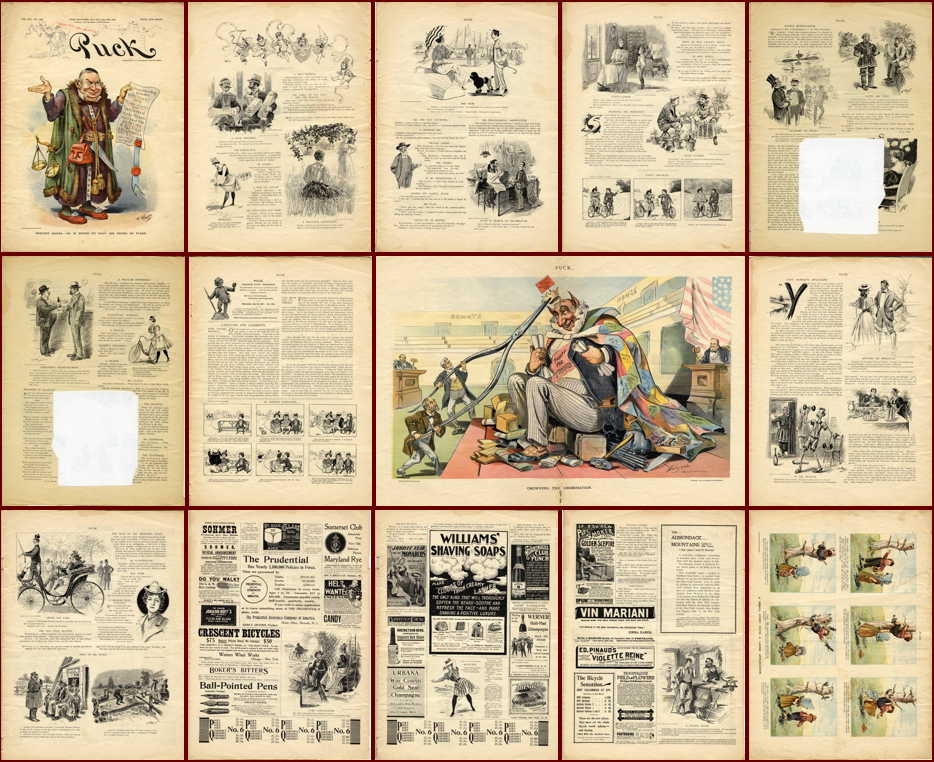 The World 'Comic Weekly' 20. June 1897 (6 pages, ie two missing) Small version - Large version  |
1900 - 1929
|
Walt McDougal Professor Jyblitz (1.2.1902)  Hank the Hermit (29.9.1912) 
|
|
Winsor McCay Comparison of McCay dragon to German Baroque theatrical design  Dream of the Rarebit Fiend (19.1.1913)  Dream of the Rarebit Fiend (27.7.1913)  |
|
Fred Opper (after 1900) Index
(see also the Pre-1900 Opper Index) Si puts in a good word for Happy Hooligan (1912)  Happy Hooligan - There might have been a lot of wisdom... (1912)  Happy Hooligan - Sometimes it almost seems as if (1913)  (Happy Hooligan in German) (Deutsches Journal 1913) 
|
Arpad Schmidthammer (1905) This was very likely an inspiration for 'The Kinder-Kids' by Lionel Feininger. Schmidthammer's 'Mucki' had just been published when Feininger (living in Germany) was commisioned by the Chicago Tribune to come up with a comic strip. The style and content, especially the trip-round-the-world nonsense, shows similarities, although Feininger is far more inventive. - Schmidthammer himself was influenced by Busch, the plump parents are classic Busch (see Tobias Knop and wife), and the gag of hanging onto the stork is lifted from Max and Moritz.
  |
Gustav Verbeek - The Upside Downs of Little Lady Lovekins and Old Man Muffaroo - The Thrilling Adventure of the Dragon (8. Mai 1904) |
P. Richards 'Die Sonntagsbeilage' (The Sunday Supplement)
Berlin, 1907
-
This is probably the first text explaining the new phenomenon of American Sunday comics to a German audience.
P.Richards was a German-American cartoonist, working in America. This is from a book of recollections, called 'Zeichner und Gezeichnete' .
Zeichner means draughtsmen/graphic artists /drawers' (Gezeichnete means 'those which have been drawn')
 |
A-Z (these lead to the links above)
|
Andral, G. B., F. von Bahr, Johann Baric Beard, Frank Bernard, Edouart Budd, C.J. Bunner, R.F. Burret, Léonce Busch, Wilhelm Caldecott, Randolph Caran d'Ache Chicki, Georges Chinese (probably late 18th c.) Chinks Chip (F.P.W.Bellew) Christophe (Georges Colomb) Cohl, Emile Clark, J.B Crowquill, Alfred Cruikshank, George Cyl, C. Daggy A.S. Dalrymple Deb Dépaquit, Jules Dio-Biding Doës |
Douhin, A. Doré, Gustave Doyle, Richard Dunk, M. Fau, Fernand Frost, A.B. Gerlach Gillray, John Godefroy Goez, Joseph Franz von Goodes, W.M. Graetz, F. Grandville, J.J. Griffin, Syd B. Heath, William Herford, O. Hoffmann, H. (Struwwelpeter) Hogarth, William Hopkins, Livingstone Howarth, F.M. Jensen, A. Keene. Charles Kemble, W.C. Kerlie? C. Koch Lagemann, Ch. Le Bocain |
Leech, John Leguey, Luc Lemot, Achille (Uzès) L., S. Leoy Le Petit, Alfred Lobrichon, Timoléon Marie Malatesta, H. ? Mandl, M. Maurier, George de May, Chas Mayer, Hy McCay, Winsor McDougal, Walt Mclenan, John Meggendorfer, Lothar Mob Monnier, M. Moriss Newell, Peter Oberländer, Adolf Opper, Fred (before 1900) Opper, Fred (after 1900) Photo Comics Piery, Emile Phillipp, H.W. Pommerhanz, Karl Pughe, J.S. |
Rabier. Benjamin Reinhardt, Carl Reichert Reinicke, Emil Rey, K. Richards, F.T. Richards, P. Ross, Charles, Marie Duval (Ally Sloper) Rowlandson, Thomas (Dr Syntax) Rusden, A. Scherenberg, H. Schönborn, R. Schliessmann, H. Schmelzer Schmidthammer, Arpad Shepherd, James A. Storch, C. Storkmann Sullivan, James Tenniel, John Theele, John Töpffer, Rodolphe Tucker, M. ? Vaiselow, M. Verbeek, Gustav Verbeek, Gustav (after 1900) Vitou, S. Unidentified Artists |
If you have questions about early comics, please direct them to this mailing list: Platinum Age Comics
Copyright © 2011 by Andy Konky Kru
Home





















